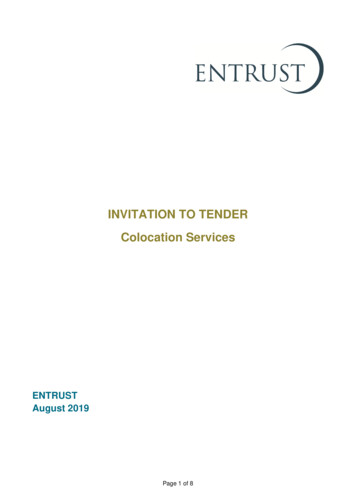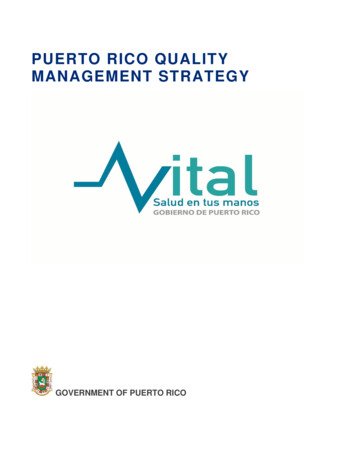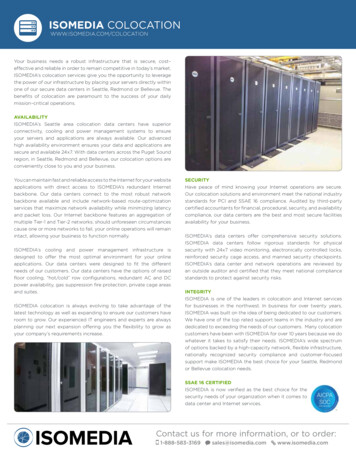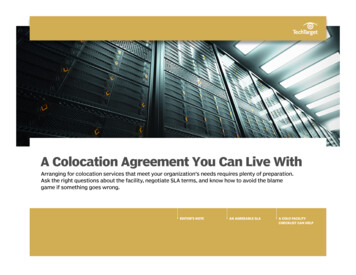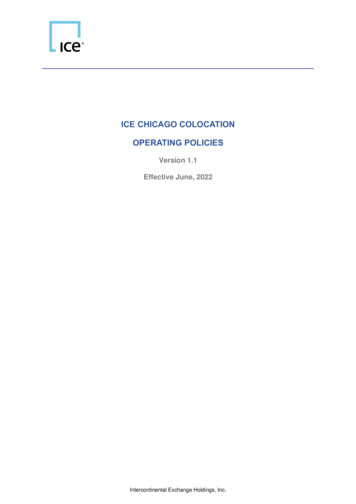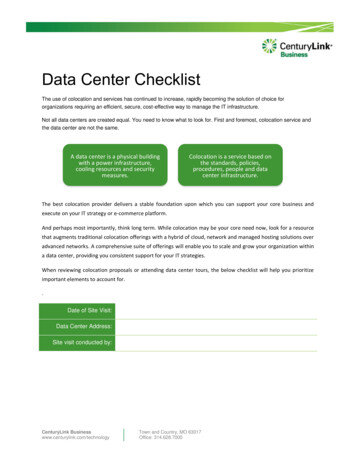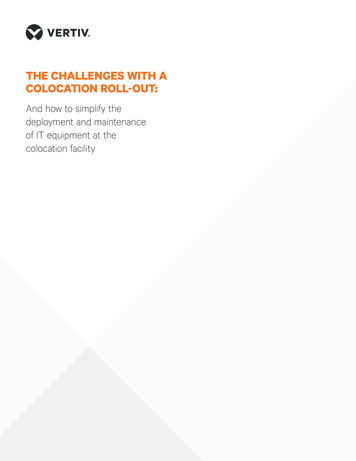
Transcription
THE CHALLENGES WITH ACOLOCATION ROLL-OUT:And how to simplify thedeployment and maintenanceof IT equipment at thecolocation facility
TWO STAGE POWER DISTRIBUTIONExecutive SummaryColocation services offer many benefits to customerslooking to migrate or expand their IT infrastructure. Theadvantages of scalability, continuity and security, drive muchof the rationalization to the business when evaluatingcolocation as an option. While the facility and infrastructureadvantages are compelling, many IT Organizationsunderestimate or overlook the operational nuances that willnegatively affect business processes and operationalexpenses when a roll-out starts. The fact that the colocationfacility is by definition remote, creates a unique set ofchallenges that need to be taken into account during theplanning phase.One downside to colocation is distance, time and costrequired to travel to the facility, especially when criticalequipment requires hands-on attention. The deployment ofIT equipment will require numerous site visits and hours ofon-site work – away from usual tools, supplies, and otherteam members.yyColocation providers often have charges and restrictionsthat govern the movement of equipment and people inand out of the facility.yyRemote equipment creates new deployment challengesfor the network and server teams since the installation,patching, and initial configuration of the operatingsystems needs to be done remotely, which requires theuse of out-of-band tools.yyAfter the system is in production, challenges withmonitoring and managing the remote infrastructure maylead to unexpected downtime, longer than usual repairtimes, and additional costs for site-visits and third-partyremote hands.This white paper introduces solutions to overcome some ofthese challenges by leveraging the products and services ofVertiv. We will look at the Vertiv SmartCabinet and how itcan help minimize the time and costs of a roll-out andon-going operations.2LEARN HOW TOyy Minimize the time your staff spends at thecolocation facilityyy Minimize number of site visitsyy Minimize costs with third-party smart-hands servicesyy Monitor the colocation environment and physicalaccess to your IT equipment
Activity CycleTo discuss the challenges of a colocation roll-out, thiswhite-paper will use the IT Activity Cycle described below.There are at least 3 phases to any IT project: plan, deploy,and support. This framework is very simple and can beused to describe the IT operations framework ofmost organizations.The Planning Phase is a complex phase in which high-levelarchitecture, individual components, and project plans aredefined. During the Deployment Phase, hardware andsoftware are received, installed and put in products. TheSupport Phase is when the system is maintained, issues areaddressed, and change requests are performed.This white-paper will focus on the Deployment and Supportphases of this framework.Deployment PhaseThe Deployment Phase starts with physically receiving allequipment for the installation. Equipment is mounted inracks and cables are run. The team in charge of the networkwill patch and configure the network equipment while theteam in charge of the servers will install and patch operatingsystems. Finally, the Applications will be installed and testedbefore the system goes into production. The Deploymentphase can be described by the diagram below.ReceiveequipmentRack& StackThere is an extensive amount of manual labor involved inthis phase – work that is critically important and yet quitetedious and time consuming. Errors in installing andconfiguring components into racks will be magnified laterwhen resources have left the site.Install &Configure OSInstall/testApps3
TWO STAGE POWER DISTRIBUTIONSupport PhaseDuring the Support Phase, the infrastructure is beingmonitored and support tickets are being resolved using avariety of tools that are available to the support team. Thesupport phase can be described by the diagram below.Administrators will resolve most of the tickets using thein-band tools available. First line support may escalatetickets to specialists who will be able to resolve more difficultissues. In-band tools include SSH for network equipmentand Linux servers, RDP for Microsoft servers, and othervendor specific tools. All in-band tools require networkconnectivity. For issues where systems are not respondingto in-band tools, out-of-band tools will be used to access thelow-level hardware interface – serial ports, keyboard-videomouse, and service processors. Out-of-band tools canusually resolve 80% of the tickets that reach this stage.When out-of-band tools are unable to resolve an issue,either because of a hardware failure or some other seriousdefect, a site visit is required.OUT-OF-BAND ACCESSOut-of-band tools allow access to low-level hardwareinterfaces of IT devices. The three types of out-of-bandinterfaces are RS232 serial ports, KVM (keyboard, video,mouse), and service processors (IPMI, andgraphic console).If an IT device is not responding to network commands,out-of-band tools are the only option before you need asite visitXXXTICKETSIN-BANDALARMS4OUT-OF-BANDSITE VISIT
The Challenges with a Colocation Roll-outWith this framework in mind, let’s look at some of thechallenges organizations may face when moving to acolocation facility. Some may consider a colocationdeployment as a simple change of address for thedatacenter space. This oversimplication may however leadorganizations to overlooking operational nuances that maynegatively affect business processes and operationalexpenses. The fact that the colocation facility is, bydefinition, remote creates a unique set of challenges thatneed to be taken into account before any roll out.DEPLOYMENT CHALLENGESyy Your team will spend a great amount of time at thecolocation site and every task will take longeryy Team coordination will be difficultyy There will be additional charges and feesDeployment ChallengesA colocation roll-out will require numerous site visits anddays of on-site work. Time spent out-of-office inherentlyreduces employee productivity consuming valuable timetravelling between locations. The lack of tools and suppliesthat are readily available at the corporate offices, and thefact that employee is physically separated from his teammembers, will decrease process efficiency.Colocation facilities have many rules that need to befollowed when receiving equipment, doing racking andstacking work, disposing of boxes, and moving equipment.Depending on the colocation, organizations may also incuradditional costs to perform these tasks at the colocationfacility. It will be necessary to invest the time to understandthe rules and all hidden charges.ReceiveequipmentRack& StackThe move to a colocation facility also requires proficiency atremote infrastructure and application management –imaging and patching equipment is different when you don’thave physical access to the device. The fact that all theequipment is remote creates new deployment challenges forthe network and server teams since the installation,patching, and initial configuration of the operating systemsneeds to be done remotely, which requires the use of out-ofband tools or site visits.Install &Configure OSInstall/testApps5
TWO STAGE POWER DISTRIBUTIONSupport ChallengesSUPPORT CHALLENGESDuring the support phase challenges include the fact thatall equipment is remote and that in-band tools requirereliable network connectivity between administrators andthe colocation facility, which can be an issue in times ofcrisis (e.g. network down, natural disasters, DDoS attacks,etc.). Therefore, out-of-band tools become critical and needto be available to resolve issues that cannot be addressedvia in-band tools. If the appropriate out-of-band tools arenot available, the cost and the number of site-visits willincrease dramatically.yy You will need the right environmental monitoringyy You will need to control and log physical access tocage and racksyy You will need the right out-of-band system in placeAlong with the out-of-band infrastructure, monitoring takeson a very important role as well. Monitoring the Colocationenvironment to make sure your equipment is being deliveredthe good power and cooling and that the Colocationenvironment will not lead to unexpected downtime.Additionally, monitoring physical access to the cage and toyour racks becomes a necessity since now the physicalsecurity of the IT equipment is outsourced to the colocationprovider. The importance of physical security to an overallelectronic security framework cannot be over-stressed.Frameworks like CISSP, HIPPA, and CPI suggest thatphysical security be taken very seriously. Organizationsneed to invest in tools that will control and monitor thephysical access to IT equipment that is deployed in acolocation facility.XXXTICKETSIN-BANDALARMS6OUT-OF-BANDSITE VISIT
Simplifying your COLOCATION roll-out with Vertiv Vertiv solutions facilitate the Deployment and Support of your colocation project by minimizing the time you will spend at thecolocation facility working on your equipment cabinets; by decreasing the time it takes to resolve issues remotely, which willminimize the number and money spent on site visits; and by monitoring the environment and the physical security at thecolocation cage to alert you when something is wrong.This value is delivered by Vertiv via its SmartCabinet platform and services. The SmartCabinet is a family of cabinets that areintegrated at the factory per your specification. The SmartCabinet will deliver the time-savings you need during the deploymentphase and will have all the capabilities necessary to remotely monitor and manage devices during your Support Phase.Minimize time spent at thecolo during deployment.ReceiveequipmentRack& StackInstall &Configure OSInstall/testAppsXXXTICKETSIN-BANDALARMSMonitor environmentand physical access.OUT-OF-BANDSITE VISITResolve Issues faster.Decrease site visits.7
SmartCabinet CAPABILITYOVERVIEWThe SmartCabinet is a set of capabilities that helps youdesign the ideal cabinet solution for your colocation roll-out.Your cabinets are factory integrated and labelled, shipped tothe colocation facility based on your schedule, and rolleddirectly from the truck to their precise location in yourcolocation cage. White Glove services can enhance thedeployment experience.CabinetsComplete line of network and server racks withcustomization capabilities. All heights, depths, and widths.Made in USA with quick response time forcustom requestsRack PDUHundreds of rack PDU’s configuration. Single/three phase.NEMA and IEC plugs. 20A, 30, 50A, and 60A. A variety ofoutlet countsSensorsTemperature, Humidity, smoke/water detectors,door switchSmartCabinet is a customization and integration service thatallows customers to realize the most value from ourcapabilities and industry leadership. There are nopre-defined SKU’s for the SmartCabinet. You work with ourteam of experts to create the configurations that will meetyour cabinet requirements. Once finalized, your cabinetsolution receives a unique part number that you will be ableto order from your preferred reseller.LocksMechanical and digital locks from 3 different vendors aresupported – new vendors are validated upon requestOut-of-bandOut-of-band support for server, network, and storageequipment. Available 3G/4G connectivity for occasionswhen all else has failedLabelingAll cabinets are labeled front, back, inside, and outside.Rack PDU’s and PDU whips are labeled. All cablespre-installed at the factory are labeledCabinet sidesIf floor plan is provided, redundant cabinet sides ofadjacent cabinets will be removed to minimize cost ofcomplete solutionAsset TrackingAsset tracking technology from two different vendors canbe installed at the factory – new vendors are validatedupon requestFirmwareConfigurationAll active equipment can be configured for networkaccess and SNMP monitoring at the factoryYou have complete flexibility to design your cabinet – ourgoal is to minimize the time you will need to spend at thecolocation facility. Our Integration capabilities are extensive,some of which are outlined in the table below.Rack/PDU/WhipsLabeledOut-of-bandDeviceRack PDU ADigital LockAsset TrackingIntrusionDetectionSensorsRack PDU BCable/AirManagementRail Spacing8
ConclusionA colocation roll-out brings with it a set of challenges thatneed to be well understood and addressed before thedeployment starts:1. Deploying IT equipment at the colocation site will requiremany site visits and a significant investment in additionaltime spent away from the home office.2. Server, storage, and network administrators will need tolearn how to perform day-to-day tasks remotely.SMARTCABINET yy Minimize the time your staff spends at thecolocation facilityyy Minimize number of site visitsyy Minimize costs with third-party smart-hands servicesyy Monitor the colocation environment and physicalaccess to your IT equipment3. Maintaining equipment that is deployed at thecolocation will require proficiency at using remotemanagement tools and a solid out-of-band strategy fortimes of crisis when the primary network connection maynot be available.All these challenges may lead to deployment delays,decrease productivity, excessive fees from colocation andthird-party remote hands, unexpected downtime due tounforeseen conditions, and delays restoring services after adowntime event.The SmartCabinet solution from Vertiv simplifies thedeployment and the maintenance of IT equipment at thecolocation by delivering a pre-integrated cabinet solutiondirectly to the colocation based on your precisespecification. The SmartCabinet will be IT-ready at themoment it is placed in your cage and will save days ofon-site work.The SmartCabinet can be equipped with all the non-ITdevices that will make your colocation roll-out a success.Power, sensors, digital locks, asset tracking, labels, andwhatever else you may need. These cabinets are fullycustomizable and we will do whatever it takes to deliver ourvalue proposition.9
VertivCo.com Vertiv Headquarters, 1050 Dearborn Drive, Columbus, OH, 43085, US 2016 Vertiv Co. All rights reserved. Vertiv, the Vertiv logo and Vertiv Liebert DSE are trademarks or registered trademarks of Vertiv Co. All other names and logos referred to are trade names, trademarks or registered trademarks of their respective owners.While every precaution has been taken to ensure accuracy and completeness herein, Vertiv Co. assumes no responsibility, and disclaims all liability, for damages resulting from use of this information or for any errors or omissions. Specifications are subject tochange without notice.SL-24689 (R01/17)
Colocation services offer many benefits to customers looking to migrate or expand their IT infrastructure. The advantages of scalability, continuity and security, drive much of the rationalization to the business when evaluating colocation as an option. While the facility and infrastructure advantages are compelling, many IT Organizations



